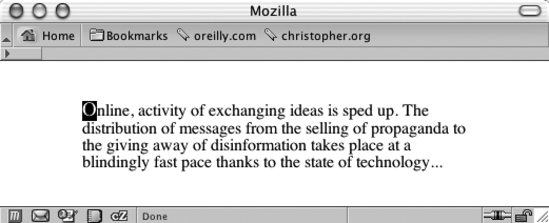Recipe 2.8. Setting a Simple Initial Cap
ProblemYou want a paragraph to begin with an initial cap. SolutionMark up the paragraph of content with a p element: <p>Online, activity of exchanging ideas is sped up. The distribution of messages from the sellin of propaganda to the giving away of disinformation takes place at a blindingly fast pace thanks to the state of technology …</p> Use the pseudo-element :first-letter to stylize the first letter of the paragraph (see Figure 2-8): p:first-letter { font-size: 1.2em; background-color: black; color: white; } Figure 2-8. A simple initial cap DiscussionThe CSS specification offers an easy way to stylize the first letter in a paragraph as a traditional initial or drop cap: use the :first-letter pseudo-element. :first-letter is supported in common modern browsers such as Internet Explorer 6 for Windows, Firefox, Safari, and Opera. For other browsers, a different approach may be needed. Wrap a span element with a class attribute around the first letter of the first sentence of the first paragraph: <p><span >O</span>nline, activity of exchanging ideas is sped up. The distribution of messages from the selling of propaganda to the giving away of disinformation takes place at a blindingly fast pace thanks to the state of technology …</p> Then set the style for the initial cap: p .initcap { font-size: 1.2em; background-color: black; color: white; }Initial caps, also known as versals, traditionally are enlarged in print to anything from a few points to three lines of text. See AlsoThe CSS 2.1 specification for the :first-letter pseudo-element at http://www.w3.org/TR/CSS21/selector.html#x52; for more information on initial caps in general, see http://fonts.lordkyl.net/fonts.php?category=vers. |
EAN: 2147483647
Pages: 235